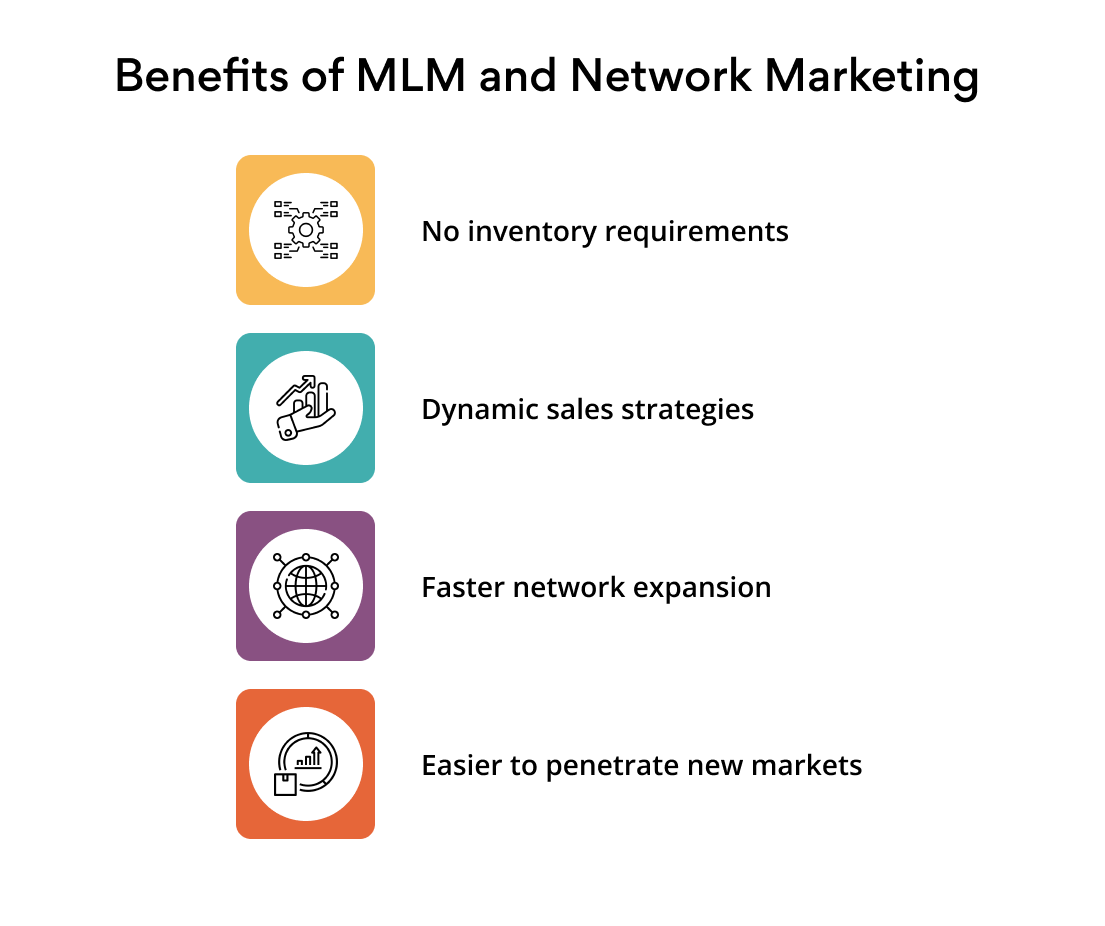As business people, we understand the struggle of constructing a reliable sales team that can work on a sturdy client funnel, bring in leads, and skyrocket sales. While having an in-house sounds promising, it also requires a significant monetary commitment, which may not be possible under your circumstances. What is your alternative?
Numerous businesses across the world have employed direct selling techniques such as network marketing and multilevel marketing to catapult their sales. What is network marketing vs MLM? Let's find out.
What is network marketing and MLM?
Network marketing (NM) is a broad category under direct selling, which also includes other direct selling techniques such as MLM, party-plan marketing and single level marketing. Network marketing refers to a chain of distributors selling products and services on a commission based payment system.
Multilevel marketing (MLM), also known as referral marketing, is a part of direct selling, used by companies to sell products and services without directly employing a sales team. Instead, MLM promotes a commission based, freelance distributor system where existing members reach out to other individuals to sell their products and services as well as bring new recruits to expand their teams.
MLM and network marketing have been popular business models since the early 1900s. Pioneer organizations such as the California Vitamin Company (renamed Nutrilite), California Perfume Company (Avon products), Oriflame, and Amway have profited from implementing MLM as a major part of their sales strategy. Since then, referral marketing has been a profitable business venture and a convenient means for individuals to earn extra cash. With an estimated global marketing size of $180 billion, the MLM industry comprises around 43 million part-time members contributing to its annual profits, according to recent surveys.
Business models such as multilevel marketing or network marketing are known to be low-risk and low-investment, high-yield strategies that can help you start your business.
Network marketing vs MLM: What's the difference?
| Features | Network marketing | MLM |
|---|---|---|
| Definition | Refers to a chain of distributors selling products and services on a commission based payment system which my not be multi-tiered. | Method of selling products and services through independent sales representatives based on a multi-tiered commission system. |
| Commission system | Less rigid, may or may not be multi-leveled. Rigid system, is multi-tiered. | Rigid system, is multi-tiered. |
| Key focus | Primary focus on direct relationship with distributors and customers, and sales. Focus is often on recruitment of downlines and selling products. | Focus is often on recruitment of downlines and selling products. |
| Specification of goods | Is implemented for the sales of only tangible goods. Can be implemented to sell non-tangible goods as well. | Can be implemented to sell non-tangible goods as well. |
| Regulations and compliances | Comparatively has less regulations Has to adhere to numerous compliances, since it runs the risk of turning into an illegal pyramid scheme. | Has to adhere to numerous compliances, since it runs the risk of turning into an illegal pyramid scheme. |
| Compensation plans | May or may not have different compensation and incentive plans for distributors. Offers many compensation plans depending on the company the distributors work with. | Offers many compensation plans depending on the company the distributors work with. |
MLM is a method of selling products and services to the target market through independent sales representatives. The representatives are not employees of the company but are incentivized with a percentage of the profit the company makes on every sale. The bottom line is that implementing multilevel marketing successfully is based on consistently encouraging existing distributors to recruit new distributors and create a diverse network (while ensuring that it does not turn into a pyramid scheme).
Coming to the MLM vs network marketing debate, is there a difference between the two terms? Yes.
MLM is often perceived to be synonymous with network marketing. True, network marketing also conforms to the idea of selling products to customers directly by creating a commission system for a non-salaried workforce. However, the commission system may or may not be multi-layered like with MLM. Besides, network marketing focuses more on a direct relationship with distributors and customers. And it requires tangible goods for sales. MLM however, can also operate with non-tangible products, with a primary focus on recruiting new distributors.
Another point in the debate of network marketing vs MLM is that network marketing is known to generate ongoing income channels for distributors solely through customer sales. MLM can also achieve similar results. However, sometimes, distributors start focusing more on earning money through recruiting downlines, rather than selling the products, and building customer relations.
MLM vs network marketing: History, meaning, differences
The concept of network marketing and MLM both stand on the core principle of not requiring any retail outlet but only a vast, growing network of people. Introduced and coined by David McConnel (founder of Avon) in the late 1800s, network marketing transitioned from a frowned upon “door-to-door” sales strategy into a thriving business model.
In 1930, Carl F Rhonberg (founder of Nutrilite) took Avon’s sales strategy to the next level where appointed distributors could advertise and sell the products through direct selling. This built a huge network and grew sales and profits, proving that network marketing was a fruitful business strategy.
How does MLM and network marketing work?
Network marketing or MLM, both work on the simple idea of expanding the distributor nexus, and direct selling to a wide range of customers.
In MLM and many instances of network marketing, the participants have two sources of income. One is selling products to the people they know, and the other is the commission on each person they onboard and on each product their recruits sell.
To earn bigger commissions, each distributor keeps recruiting more participants in their team (also called the downline). The new entrants, in turn, start adding more people to their teams, and so on. This process continues at multiple levels.
A distributor is not paid immediately when a new participant is recruited in the downline. They are compensated by a percentage of the sales from their team. Therefore, to make this a viable income source, the distributors must recruit as many downlines to their team as possible.
Network marketing only adheres to these recruiting patterns when it is following a multi-leveled approach of sales. Otherwise, it can also follow the single level marketing model where distributors simply sell the products to customers and earn commission by applying effective network marketing tips and strategies.
Now, let's dig in on how MLM vs network marketing can help you grow your sales.
Benefits of MLM and network marketing for businesses

As a business, there are numerous benefits to implementing an MLM or network marketing model for your sales.
No inventory expense: MLM does not require businesses to have a brick-and-mortar outlet to reach out to their customers. This helps them save on the inventory carrying cost, along with the fixed expenditure of maintaining a shop.
Dynamic sales forums: Network marketing allows businesses to be creative with their sales strategies. They can reach out to their customers through numerous channels, such as email marketing, phone calls, advertising, etc.
Using social media: Many MLM participants employ creative social media strategies to advertise their products. Engaging in social media marketing helps MLM distributors reach a wider network of customers, without investing much. Moreover, social media channels also help in seamlessly building a reliable community of followers and interacting with interested candidates to increase their downlines.
Low sales expense: MLM ensures a low sales expenditure for companies, and thus a higher profit for your business. Network marketing eliminates the need for traditional marketing such as advertising, promotional activities, etc, since the distributors create their own sales strategy for selling the products.
A growing salesforce: Implementing MLM promises a growing sales network since the distributors consistently recruit more participants to their downline. Besides, this saves the companies from recurring hiring expenses, along with employee salaries and overhead expenses.
Flexible and dynamic team: A popular advantage of implementing network marketing for your business is that you get to work with a vast workforce, from different parts of the world. Additionally, MLM allows its distributors to be from any educational background which brings plenty of dynamism and creativity to the table.
Business growth and expansion: Working with a strong network of distributors and customers, MLM opens up the possibility of a global customer reach and business expansion. Implementing MLM as your business strategy enables you to recruit downlines from any location. It allows the business to step into the international market and tap into the potential of numerous growing economies of the world.
Benefits of multilevel marketing and network marketing for individuals
Network marketing and MLM are beneficial business models for companies. However, they are also an efficient and lucrative way to earn money for individuals. Participants (with or without advanced degrees) can work remotely and have the flexibility of choosing their working hours. It also provides the candidates the opportunity to work part-time, and have a side income. According to recent surveys, around 51% of network marketers invest about 10 to 30 hours per week in this hustle. Besides, nearly 82.4% of those participating in network marketing do so on a part-time basis.
What makes MLM and network marketing a convenient source of income for individuals globally?
Since it is a commission based business, it allows people to work as much as they want to earn. Besides, what makes MLM and network marketing a convenient source of income is it does not require the team to work from a single location. You can be from any part of the world to work as a network marketing distributor. Additionally, distributors with a sizable downline network don’t have to sell the products themselves since the commission they receive from their downlines is sufficient. So, if you’re an individual with an entrepreneurial drive, working as a network marketer will be a viable business venture for you.
MLM vs network marketing – Building customer relations
Building of customer relations may vary in both sales models. In MLM, the primary focus often shifts between recruiting new distributors and cultivating long-term customer relationships. The emphasis on recruitment involves encouraging new recruits to buy into the business opportunity and make purchases themselves. MLM distributors may sometimes make exaggerated claims about potential earnings to attract new members, which can lead to a disconnect between the company and the end customer.
As a result, customer relationships in MLM tend to be transactional, with the primary goal being to make a sale or secure a new recruit, followed by providing value, support, and ongoing engagement.
Moreover, the recruitment-focused approach can undermine trust and negatively impact the customer experience. The transactional nature of MLM customer relationships is often perceived that distributors prioritize immediate sales over long-term customer satisfaction and loyalty.
In many cases, network marketing emphasizes more on building direct, personal relationships between distributors and customers. The primary focus is on providing value, support, and customer experience. Network marketing distributors are trained to have thorough knowledge of the products, offer tailored solutions to customers, and ensure satisfaction. The distributor-customer relationship is central to the business model, with compensation plans structured to reward distributors for direct sales to customers rather than merely for recruiting new members.
Network marketing companies emphasize the need for tangible products that have real end-user demand. Distributors are required to explain the features and benefits of the products to potential customers in a consultative manner, fostering customer loyalty and repeat business. By building their businesses through referrals and repeat purchases, network marketing distributors are incentivized to focus on maintaining strong customer relationships and providing value.
MLM vs network marketing: Compensation plans
MLM and network marketing have different compensation plans for their distributors. The structure is mainly dependent on the various levels of the downline, as well as the number of participants in a program.
MLM compensation plans
Structure of compensation plans: MLM compensation plans involve a multi-tiered structure where participants earn commissions not only from their own sales but also from the sales made by their recruits, known as their downline.
- Binary plan: The binary plan allows participants to have two downlines (legs) and rewards them based on balancing these legs.
- Unilevel plan: This plan permits distributors to recruit an unlimited number of members on their frontline, enabling them to earn commissions based on their direct sales and those of their recruits.
- Matrix plan: This features a fixed width and depth, limiting the number of recruits at each level, which can enhance earnings through a structured grid system.
Earning potential: In MLM, earnings are often derived from both personal sales and a percentage of the sales generated by downline MLM members. This structure creates significant income potential for those who successfully recruit and build large teams. However, it can also lead to income disparities, with top earners profiting disproportionately compared to those at lower levels.
Incentives and bonuses: MLMs often include various bonuses such as matching bonuses, rank advancement bonuses, and leadership bonuses. These bonuses reward participants for their performance and the performance of their recruits, incentivizing not just sales but also recruitment and team building.
Network marketing compensation plans
Structure of compensation plans: Unlike MLM, network marketing compensation plans can be less rigid and may not always follow a multi-level structure. These plans often focus more on direct sales and may include simpler commission structures without the extensive tiered levels characteristic of MLMs. Network marketing plans may also provide single-level commissions ie., rewarding distributors based on their personal sales rather than recruitment.
Earning potential: Network marketing typically focuses on sales commissions derived from personal sales. This approach can lead to a more stable income for participants who excel in sales without heavily relying on building a downline. There is generally less emphasis on recruitment, resulting in potentially more predictable and stable earnings.
Incentives and bonuses: While network marketing plans may include bonuses, they are generally not as complex or tiered as those in MLM. With network marketing, the focus is on rewarding direct sales efforts, which simplifies the compensation structure.
While both MLM and network marketing involve selling products and recruiting others, their compensation plans differ significantly. MLMs typically have more complex, multi-tiered structures with a focus on recruitment, whereas network marketing often emphasizes direct sales with simpler compensation mechanisms.
Is MLM and network marketing risky as a business model?
While MLM and network marketing have proven to be very profitable business ventures since their conception, high profits often mean some risk. Following are the disadvantages of deploying MLM and network marketing:
1. The 70% rule
For an MLM model to be legitimate (i.e., not a pyramid scheme) and profitable for all, it must adhere to the ‘70% Rule’. The rule states that at least 70% of the inventory must be purchased by non-distributors. Companies often cannot maintain this ratio because they are unable to track their distributors’ sales without an MLM software.
2. Pyramid scheme
Another risk of implementing MLM as a business strategy is that it could become a pyramid scheme. This happens when the distributors focus solely on recruiting new participants to their downline, but the sales of the products are zilch.
Pyramid schemes are associated with onboarding new members as investors with a promise of high returns without really selling a product or service. There is a fine line between an MLM and pyramid scheme—while MLM is a legit sales strategy, pyramid schemes are fraudulent and illegal.
3. Regulatory and legal compliances
MLM companies have to adhere to stringent regulations that require compliance with specific laws governing direct selling. It is necessary for companies to be transparent about their sales, profits, mlm inventory, etc. They also are required to provide legitimate data about the expenses incurred by participants. Additionally, making false claims while selling the products or hiring new recruits is also illegal.
Due to the potential of turning into a pyramid scheme MLMs often face more scrutiny regarding their compensation structures. Effective MLM plans must ensure that a significant portion of sales comes from retail customers rather than just internal sales among distributors. That said, training the distributors and providing full knowledge on the compliances and regulations can help you mitigate these risks easily.
Failure to comply may result in legal action from regulatory bodies such as the Federal Trade Commission (FTC) in the United States. Network marketing companies; if operating in a manner similar to MLM businesses are also subject to adhering to these compliances. Network marketing generally faces fewer regulatory challenges as long as the focus remains on product sales rather than recruitment. This can make network marketing a more straightforward model for participants and companies alike, ensuring simpler compliance.
4. Complex compensation structures
True to its name, the MLM sales model follows a multi-leveled compensation system for its distributors. This can lead to legal outcomes if they are perceived as unfair or if they reward recruitment over selling products. Besides, managing a multi-leveled compensation plan for thousands of participants can be a huge challenge without an MLM platform.
Network marketing, may be a relatively simpler and more straightforward business strategy—if it's not multi-tiered like MLM.
The complexity of both the models can be confusing for businesses, and give rise to disputes among distributors, violating regulations such as consumer protection laws.
The aforementioned pointers may be a deterrent for companies to implement MLM and in some cases, network marketing in their business strategies. However, these risks can also be mitigated and avoided with careful legal oversight and adherence to ethical practices within MLM operations.
Discover how we build resilient businesses with advanced MLM functionalities
Conclusion
Since its conception, MLM and network marketing has been a representative of a dynamic and profitable business model for the global market. The direct selling industry is known to create around 5,500 jobs in the US per year, with an annual industry revenue of approximately $40 billion in sales.
Considering its promising returns, seamless integration of digitalization, and latest technologies, coupled with a convenient income source, it is a beneficial marketing strategy if implemented strategically. It not only has the potential to provide financial stability to individuals but also carves a path of success for businesses aspiring to work with emerging trends and a continually evolving global economy.









Leave your comment
Fill up and remark your valuable comment.